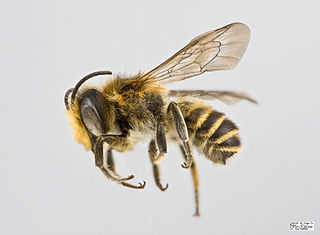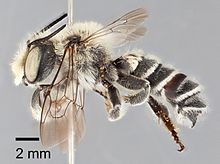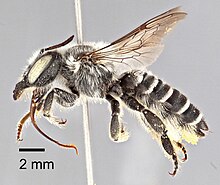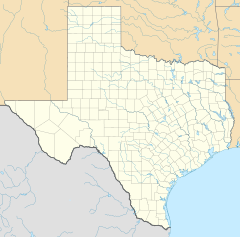
Megachile rotundata, the alfalfa leafcutting bee, is a European bee that has been introduced to various regions around the world. As a solitary bee species, it does not build colonies or store honey, but is a very efficient pollinator of alfalfa, carrots, other vegetables and some fruits. Because of this, farmers often use M. rotundata as a pollination aid by distributing M. rotundata prepupae around their crops. Each female will construct and provision her own nest, which is built in old trees or log tunnels. Being a leafcutter bee, these nests are lined with cut leaves. These bees feed on pollen and nectar and display sexual dimorphism. This species has been known to bite and sting, however it poses no overall danger unless it is threatened or harmed and its sting has been described as half as painful as a honey bee's.

Megachilidae is a cosmopolitan family of mostly solitary bees whose pollen-carrying structure is restricted to the ventral surface of the abdomen. Megachilid genera are most commonly known as mason bees and leafcutter bees, reflecting the materials from which they build their nest cells ; a few collect plant or animal hairs and fibers, and are called carder bees, while others use plant resins in nest construction and are correspondingly called resin bees. All species feed on nectar and pollen, but a few are kleptoparasites, feeding on pollen collected by other megachilid bees. Parasitic species do not possess scopae. The motion of Megachilidae in the reproductive structures of flowers is energetic and swimming-like; this agitation releases large amounts of pollen.

Megachile pluto, also known as Wallace's giant bee or raja ofu, is a very large Indonesian resin bee. It is the largest known living bee species. It was believed to be extinct until several specimens were discovered in 1981. There were no further confirmed sightings until two specimen were collected and sold on eBay in 2018. A live female was found and filmed for the first time in 2019.

The Big Bend slider, also called the Mexican Plateau slider, is a species of aquatic turtle in the family Emydidae. The species is endemic to the Southwestern United States and northern Mexico.

The genus Megachile is a cosmopolitan group of solitary bees, often called leafcutter bees or leafcutting bees; it also includes the called resin bees and mortar bees. While other genera within the family Megachilidae may chew leaves or petals into fragments to build their nests, certain species within Megachile neatly cut pieces of leaves or petals, hence their common name. This is one of the largest genera of bees, with more than 1500 species in over 50 subgenera. The introduced alfalfa leafcutter bee is managed for crop pollination in various regions around the world.
Plectrohyla hartwegi is a species of frog in the family Hylidae. It is found in the Sierra Madre de Chiapas and eastern Oaxaca in Mexico, Sierra de los Cuchumatanes in western Guatemala as well as Sierra de las Minas in eastern Guatemala, and Sierra de Omoa in southwestern Honduras. It might be a composite of two or more species.
Hartweg's climbing salamander, also known as Hartweg's mushroomtongue salamander, and Hartweg's salamander, is a species of salamander in the family Plethodontidae. It is found in the north-central Chiapas, Mexico, and the adjacent Guatemalan Sierra de los Cuchumatanes.

The moustached kingfisher, also called Bougainville moustached kingfisher, is a species of bird in the family Alcedinidae. It is endemic to Bougainville Island in Papua New Guinea. An estimated 250–1,000 mature individuals are left.
Wimmeria mexicana is a large shrub or small tree, often reaching 8 metres (26 ft) in height, that is common in the Southeastern United States and in regions of Mexico, including the states of Oaxaca, Chihuahua, and central to eastern Sonora. It is commonly called papelío and algodoncillo.

Megachile sculpturalis, known as the giant resin bee and sculptured resin bee, is a species of leafcutting bees belonging to the family Megachilidae.
Anthemurgus passiflorae is a small, black, bee that occurs from central Texas to North Carolina and north to Illinois. Females of this solitary bee use collected nectar and pollen to feed larvae located in nests constructed in the ground. This uncommon bee is unusual for two reasons: first, the only known pollen host is a single species—the yellow passionflower ; second, because of its size and foraging habits, the passionflower bee is thought to contribute little or nothing toward the pollination of its host plant. Female bees remove pollen from P. lutea by suspending themselves under an anther and scraping the pollen out with open mandibles. This unique position of pollen collection almost never results in pollination as the female bee rarely touches the stigma. The genus Anthemurgus contains only the passionflower bee and thus is a monotypic taxon, though some recent authorities treat Anthemurgus as a monotypic subgenus within the genus Pseudopanurgus (e.g.).

Megachile campanulae, known as the bellflower resin bee, is a species of bee in the family Megachilidae. Described in 1903, these solitary bees are native to eastern North America. Studies in 2013 placed them among the first insect species to use synthetic materials for making nests. They are considered mason bees, which is a common descriptor of bees in several families, including Megachilidae. Within the genus Megachile, frequently also referred to as leafcutter bees, M. campanulae is a member of the subgenus Chelostomoides, which do not construct nests from cut leaves, but rather from plant resins and other materials. Females lay eggs in nests constructed with individual cell compartments for each egg. Once hatched, the eggs progress through larval stages and subsequently will overwinter as pupae. The bees are susceptible to parasitism from several other bee species, which act as brood parasites. They are medium-sized bees and the female adults are typically larger than the males. They are important pollinators of numerous native plant species throughout their range.

Coelioxys sodalis is a bee from the family Megachilidae, one of numerous kleptoparasitic bees in the tribe Megachilini. Members of the genus Coelioxys exhibit kleptoparasitic behavior in that they lay their eggs in the nests of other bees, typically those of the related genus Megachile. As this behavior is similar to that of cuckoos, such bees are referred to as cuckoo bees. These host-parasite relationships are complex Host insects of the brood parasite C. sodalis include Megachile melanophaea, M. texana, and M. rotundata.

Megachile melanophaea is a species of leaf-cutter bee in the family Megachilidae. It was first described by the British zoologist Frederick Smith in 1853. It is native to North America.

Megachile texana, the Texas leafcutter bee, is a species of bee in the family Megachilidae. It was first described by the American entomologist Ezra Townsend Cresson in 1878. It is native to the United States and southern Canada.

Megachile centuncularis, commonly known as the patchwork leafcutter bee, is a species of bee in the family Megachilidae. It was first described by the Swedish naturalist Carl Linnaeus in 1758.

Megachile maritima, common name coast leaf-cutter, is a species of leaf-cutter bees in the family Megachilidae. It was described by William Kirby in 1802.

Ipomoea oenotherae is a species of plant of the morning glory genus, Ipomoea, in the family Convolvulaceae. It derives its name from the resemblance it bears to plants in the genus Oenothera. Ipomoea oenotherae is a succulent and a cryptophyte.

Protohabropoda is an extinct genus of bees in the family Apidae known from a fossil found in Europe. The genus currently contains a single described species Protohabropoda pauli.

Bombus trophonius is an extinct species of bumble bee known from a Miocene fossil found in Europe. It belongs to the Bombus subgenus Cullumanobombus and is considered most similar to the living species Bombus rufocinctus of North America.




















